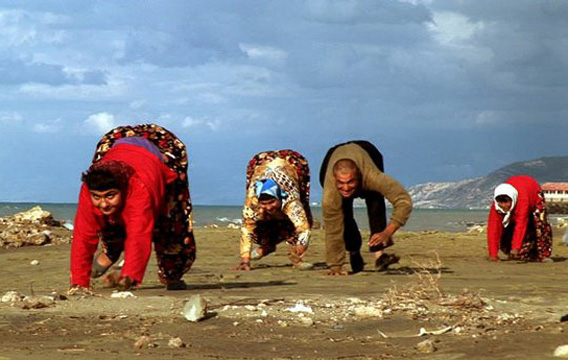By: Nicholas Day
I’m bipedal! You’re also bipedal. Who isn’t bipedal, really? No one brags about getting around on two legs. No one uses it as a pickup line (I presume). In our human-ruled world, bipedalism is so ubiquitous that we barely notice it, much less marvel at it.
But maybe we should.
In the herky-jerky world of infant locomotion, there’s a type of crawling that has long stood out for its unlikely grace and speed: bear crawling. It sounds ridiculous—hands and feet on the ground, knees and back off it—but it turns out to be strangely efficient. Toddlers who hit upon this style early on often stick with it for months or years, even after they learn to walk.
The bear crawl somehow seems to be heritable, too. It runs in families. The early anthropologist Aleš Hrdlička was so fascinated by the phenomenon that he published a book on it—Children Who Run on All Fours: And Other Animal-Like Behaviors in the Human Child—back in 1931, consisting mostly of correspondence with the parents of bear walkers. “I am so glad my six ‘monkeys’ are of interest to you, for I always insisted that it was interesting for a whole family to run about like that,” wrote a mother from Tennessee. A man from Chapel Hill wrote in about his nephew, who could walk perfectly well but loved to trot on all fours and “would cover ground at a rate somewhat faster than a man would ordinarily walk; he never seemed to tire.”
The accounts were not always strictly on topic—“As an interesting incident may be mentioned that once in running on all fours he picked up an apple with his teeth. Sincerely, Chester L and Mrs. Fordney”—but Hrdlička dutifully tabulated them, reprinted a few photographs of the bear crawl in the wild, and essayed a few conclusions. The basic cause, he wrote, “is apparently of atavistic nature, the whole phenomenon being thus one of the order of functional reminiscences of an ancestral condition.” Which means, basically: These children are acting like the apes their ancestors once were.
The subject of bear crawling hibernated for many decades until a couple of Turkish doctors, in 2004, made a discovery that was more science fiction than science. In a rural village, they happened upon a group of siblings who had never stood up. Members of a family with 19 children, all of whom bear-walked in their infancy, these five brothers and sisters had never lifted up off their hands. They had walked like bears all their life. The siblings actually wrist-walked, with their palms pressed flat against the ground. (Think of someone doing the downward-facing dog yoga pose while walking.) No one had ever seen an adult human move like this before.
The siblings were able to stand upright if they really concentrated on it, an early report on them noted, “but they become unsteady if they try to walk bipedally, and soon go down onto their hands.” They were quadrupeds. To help support the family, the lone male bear crawler ranged as far as a mile from home collecting cans and bottles. While bear-crawling, he was indefatigable. “This contrasts markedly with normal adult humans,” the report noted, “who find such a gait—if and when they try it—tiring and uncomfortable even after practice.”
The siblings all had a poorly developed cerebellum, the area of the brain that controls for balance, but some humans with no cerebellum still walk. (One of their brothers had the same poorly developed cerebellum but still walked.) So why did these siblings never stand up? Hrdlička presumably would have argued that they were reverting to “an atavistic nature,” and the Turkish scientists did too: They contended that the siblings were a case of “reverse evolution,” a missing link to our quadruped past.
There’s a less outlandish explanation, though. The bear crawl was efficient enough that if the siblings had floundered at walking early on, and they likely did, they might have just given up on walking. They lived in a rural village and kept to their own family. Their parents had accepted the children as they were; they’d never tried to teach them to walk. In this very proscribed world, walking on hands and feet made nearly as much sense as walking upright. They had created their own culture. And in fact the Turkish siblings were always capable of walking: After their story made the news, they received motor therapy. They soon became bipedal. (They also became the subject of a documentary: It is worth watching just to see adult humans move in this way.)
A perfectly healthy child will always, eventually, be bipedal. But there are many children with serious neural impairments, and the story of the Turkish siblings suggests that if these children were left alone, at least some might not find their way to their feet. Without social pressure and parental encouragement—just one more step, honey, one more step—the Turkish siblings might not be nearly as weird as they seem. Indeed, only a couple of years after the siblings were found, they were no longer complete anomalies: A family with three quadrupedal brothers had been discovered in Iraq, followed by another Turkish family and a couple of families in South America.
Bipedalism is fundamental to what made humans human. In the fossil record, it shows up millions of years before tool use or the explosion in brain size. As much as any other characteristic, walking is what shaped us into human beings. But we can still discard it. It can be our most profound inheritance and still be more flexible, less hard-wired than we assume. As the psychologist Esther Thelen argued, walking isn’t built-in, locked away in some inviolable part of ourselves and our genome. It’s discovered anew by every infant. And development, despite its constraints, despite its usual predictability, is a creative, highly sensitive process: It still has, in some isolated corners of the world, the capacity to surprise us.
Originally posted on: Slate





